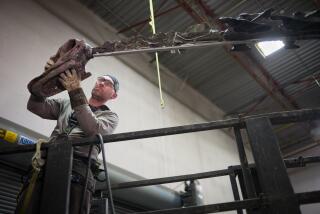For Space Station Project, Dull Acronyms Just Don’t Fly
- Share via
CAPE CANAVERAL, Fla. — As if construction delays and rising costs weren’t enough, NASA is grappling with another space station dilemma: What to call it?
The international space station has no name other than International Space Station or ISS for short--the usual NASA alphabet soup.
Station managers want a real name.
Astronauts really want a real name.
And public affairs types really, really want something catchier than ISS, pronounced letter by letter: I-S-S.
“It’s another NASA acronym, isn’t it?” astronaut Franklin Chang-Diaz observed this month while training for shuttle Discovery’s upcoming flight to Russia’s Mir station.
“Antiseptic,” grumbled another astronaut, who asked to remain nameless--just like the station.
Naming the yet-to-fly space station isn’t as easy as it sounds, officials maintain, since 16 countries are involved in the project and would have to agree on a moniker. What’s more, NASA would have to confer with the White House, said John-David Bartoe, research manager for the station program.
“This is not just a half-dozen people sitting around a table coming up with the answer,” Bartoe said.
Here are a few snags, just for starters:
The Russians “take umbrage” at Alpha or any other name that suggests a beginning or a first, said Bill Bates, chief of staff for NASA’s international space station program. After all, they point out, their country has been flying space stations since Salyut 1 in 1971.
And forget about naming the space station after an explorer or some other historical figure. It would be a thorny nationalistic issue for the European Space Agency, although its lab module has long been called Columbus after you know who. Besides, the Japanese Space Agency would balk.
“To the Japanese, you don’t put people’s names on inanimate objects. It’s against their culture. They go more with signs of nature like flowers or things like that,” Bates said.
It’s not as though the space station never had a name.
President Reagan christened it Freedom in 1988; he liked the patriotic ring. The then-Soviets already had snagged the name Peace--in Russian, Mir.
By the early 1990s, NASA’s redesigned and re-redesigned space station had become informally known as Alpha, the first letter of the Greek alphabet. At the same time, space program employees suggested hundreds of names, and NASA whittled the list in 1993 to five: Alpha, Alliance, Aurora, Sigma and Unity.
But then the Russians signed on, and it was goodbye Alpha.
Despite the cultural and political hurdles, the space agencies’ unofficial goal is to have a jargon-free name before orbital assembly begins this year--or at the very least to have a jargon-free name for each major part before each part is launched.
NASA and the Russian Space Agency should have begun hauling up parts this summer, but everything’s on hold until September or possibly even December because of Russia’s inability to launch a key component by the end of 1998.
“I’m so focused on getting the thing going,” Bates said, “that when somebody says, ‘Doesn’t it bother you calling it ISS?’ No. But.”
His but is this: Part of the appeal of NASA’s wildly successful Mars Pathfinder mission last year was the names.
“Every rock it went to visit had a good name. You had Snoopy. Whatever. I can’t remember all of them,” Bates said. (Actually, it was Yogi. But hey, whatever.)
“At the time, it meant something to you, and the public was tied into it,” Bates said. “The public was interested, and we’ve had that pointed out to us, that we get so carried away with our techno-babble that we’re our own worst enemy.”
Space shuttle commander Charles Precourt, who will lead NASA’s last flight to Mir next month, says it straight out: ISS simply doesn’t click.
“It’s very hard for me to go around and talk to people about ISS and have to explain that it’s the international space station,” Precourt said. “If it had a name . . . it would be much easier to talk about it.”
As a step toward personifying the space station, NASA this spring named the first component it will send up: Unity. This connecting passageway, the second link in the outpost, will be launched aboard shuttle Endeavour and attached to a Russian-launched control module. Until it was tagged Unity, it was called the node. That’s right, node.
NASA promises more easy-to-digest names in the months ahead. The space agency may ask schoolchildren to propose names for other pressurized station chambers, like the U.S. lab. That’s how Endeavour got its name, after all.
“Maybe the kids can come up with something,” astronaut Chang-Diaz said, hopefully.
More to Read
Sign up for Essential California
The most important California stories and recommendations in your inbox every morning.
You may occasionally receive promotional content from the Los Angeles Times.













